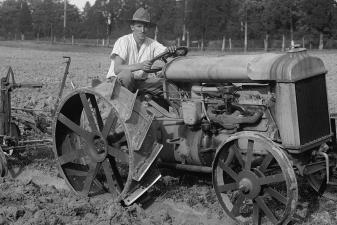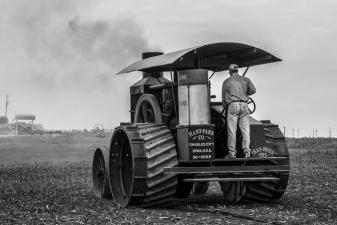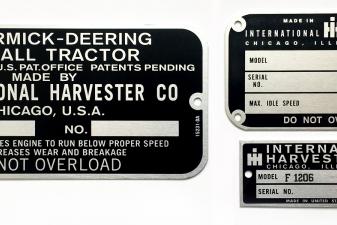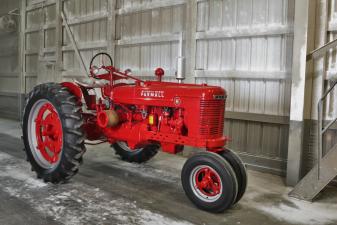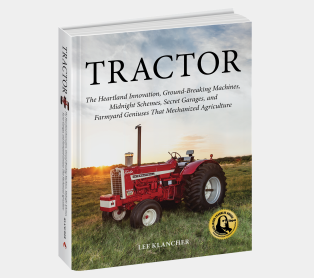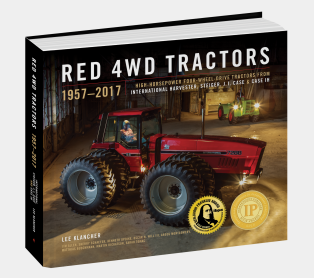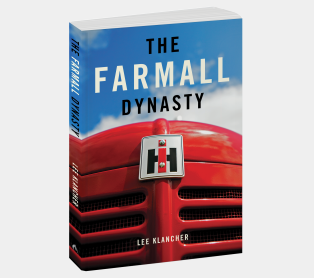Side by Side: Farmall H versus the J.I. Case Model SC
An excerpt from TRACTOR

In this week’s blogpost, we explore two of the most influential models in tractor history: The Farmall H and the J.I. Case Model S. The Model S was designed in response to the Farmall H, and the two models fought it out on the marketplace with vigor. Read about both below and find the full list of top tractors (163 to be exact!) in the upcoming book, TRACTOR, by Lee Klancher.
1954 FARMALL H
Origin: Chicago, Illinois
Company: International Harvester Company
By 1953, International’s large Farmall H and M had been on the market for fourteen years. Farms were getting bigger, and operators needed more precise speed control, improved implement control, and higher horsepower. Management’s focus was on growing the company with a broader product line rather than maintaining its stranglehold on the tractor industry. The industry, in the meantime, was innovating.
The Farmalls desperately needed a major upgrade, and the Super models that appeared in 1953 added more power and a few key upgrades. In 1954 only, the Super MTA introduced the torque amplifier, a two-speed gear-range transmission added to the regular one that could be shifted on the fly.
While the Supers were immensely popular tractors, the fact that this top-selling line was left fallow for nearly a decade and a half left the door open for other manufacturers to catch up.
 Jim Johnson Collection / Lee Klancher
Jim Johnson Collection / Lee Klancher
--------------------------------
1954 CASE MODEL SC
Origin: Racine, Wisconsin
Company: J. I. Case Company
In the 1920s, J.I. Case had all it could do to maintain the number three position in the industry. The company appointed Leon Clausen, who had been a high-level manager in the railroad industry and for John Deere. Opinionated, driven and a micro-manager, Clausen was yin and yang to the company. He drove change and helped them compete—he also enforced his opinions as the rule of law. For example, the company improved sales by ditching the drab gray paint in favor of a vivacious Flambeau Red in 1938, but Clausen later ignored complaints that the color was too close to Persian Orange.
One of the hot trends of the late 1930s was small one-plow tractors, and the Allis-Chalmers B and Farmall A & B were the market leaders. Clausen was reluctant to enter the small tractor market due to the thin profit margins. He also believed the Ferguson draft control system was foolish. His opinions slowed progress, although they did eventually get into this market with the Model V series tractors.
The Model S was a response to the market designed to compete head-to-head with the Farmall H, and it did so with aplomb. The machine combined an improved, higher-rpm engine with the layout and design from the Model D. The Model SC was the row-crop version of the Model S.
Clausen’s interest in controlling every aspect of engineering was such that he left behind a half-day’s correspondence with an engineer about whether or not to include a fuel sediment bowl that cost pennies. He also liked to argue with salespeople, telling them that the equipment was exactly what they needed and their job was to sell.
The legendary chicken roost steering—the steering control rod that jutted out awkwardly on the early Case tractors—was said to have been held in production because Clausen did not have an issue with it.
Under his leadership, however, J.I. Case gained more than they lost. By 1949, the company had introduced a proprietary draft control hitch (the Eagle Hitch), and was sharpening its sales pitch to offer the “Big Bargain” in tractors. Offering smartly-engineered machines at prices lower than the competition worked, as J.I. Case increased its market share from 3.7 percent in 1944 to 7.0 percent in 1948.
 Wakeman Collection / Lee Klancher
Wakeman Collection / Lee Klancher
Find the full list of top tractors (163 to be exact!) in the upcoming book, TRACTOR, by Lee Klancher. TRACTOR is available for presale now, books ship September 3.
1954 FARMALL H
Origin: Chicago, Illinois
Company: International Harvester Company
By 1953, International’s large Farmall H and M had been on the market for fourteen years. Farms were getting bigger, and operators needed more precise speed control, improved implement control, and higher horsepower. Management’s focus was on growing the company with a broader product line rather than maintaining its stranglehold on the tractor industry. The industry, in the meantime, was innovating.
The Farmalls desperately needed a major upgrade, and the Super models that appeared in 1953 added more power and a few key upgrades. In 1954 only, the Super MTA introduced the torque amplifier, a two-speed gear-range transmission added to the regular one that could be shifted on the fly.
While the Supers were immensely popular tractors, the fact that this top-selling line was left fallow for nearly a decade and a half left the door open for other manufacturers to catch up.
 Jim Johnson Collection / Lee Klancher
Jim Johnson Collection / Lee Klancher--------------------------------
1954 CASE MODEL SC
Origin: Racine, Wisconsin
Company: J. I. Case Company
In the 1920s, J.I. Case had all it could do to maintain the number three position in the industry. The company appointed Leon Clausen, who had been a high-level manager in the railroad industry and for John Deere. Opinionated, driven and a micro-manager, Clausen was yin and yang to the company. He drove change and helped them compete—he also enforced his opinions as the rule of law. For example, the company improved sales by ditching the drab gray paint in favor of a vivacious Flambeau Red in 1938, but Clausen later ignored complaints that the color was too close to Persian Orange.
One of the hot trends of the late 1930s was small one-plow tractors, and the Allis-Chalmers B and Farmall A & B were the market leaders. Clausen was reluctant to enter the small tractor market due to the thin profit margins. He also believed the Ferguson draft control system was foolish. His opinions slowed progress, although they did eventually get into this market with the Model V series tractors.
The Model S was a response to the market designed to compete head-to-head with the Farmall H, and it did so with aplomb. The machine combined an improved, higher-rpm engine with the layout and design from the Model D. The Model SC was the row-crop version of the Model S.
Clausen’s interest in controlling every aspect of engineering was such that he left behind a half-day’s correspondence with an engineer about whether or not to include a fuel sediment bowl that cost pennies. He also liked to argue with salespeople, telling them that the equipment was exactly what they needed and their job was to sell.
The legendary chicken roost steering—the steering control rod that jutted out awkwardly on the early Case tractors—was said to have been held in production because Clausen did not have an issue with it.
Under his leadership, however, J.I. Case gained more than they lost. By 1949, the company had introduced a proprietary draft control hitch (the Eagle Hitch), and was sharpening its sales pitch to offer the “Big Bargain” in tractors. Offering smartly-engineered machines at prices lower than the competition worked, as J.I. Case increased its market share from 3.7 percent in 1944 to 7.0 percent in 1948.
 Wakeman Collection / Lee Klancher
Wakeman Collection / Lee KlancherFind the full list of top tractors (163 to be exact!) in the upcoming book, TRACTOR, by Lee Klancher. TRACTOR is available for presale now, books ship September 3.


